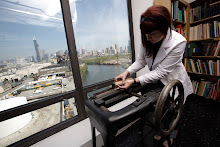 [Zoe Leonard]
[Zoe Leonard]Johanna Burton begins her essay, New York, Beside Itself, with recounting another author's memory of walking through the streets post September 11th and still expecting to see the Twin Towers. The author, Eve Kosofsky Sedgwick, recounts that she would feel compelled to look South, even if not heading in that direction on Fifth Avenue to still see if they were there, or, redirect her mind that of course they would come back, they wouldn't leave forever. How we identify landmarks, whatever their beauty or purpose aids in our orientation within the city [ala people like Haussmann and Kevin Lynch]. Burton begins to equate the urban landscape with a face, not the same, but in some ways in terms that for quite some time, the city has been considered by many to be a living entity, encompassing the organic, responsive and transitional. We could look for the same cues of familiarity that we associate so much with human expression, it's readability, to explore and connect further to the city.



In Burton's opening with reflections upon Sedgwick, she explores too how some contemporary artists working with and within New York City after 9/11 didn't necessarily make work that directly commented on the impact of the event. This statement makes me think to our Monday meeting in the Museum of Contemporary Photography in which we conversed with Natasha Egan about Chinese artists working in urban China. One of the questions raised was, in China after the Cultural Revolution, are any artists free from having their work associated implicitly with being political? What are our preconceived notions or methods for putting a piece in context for our understanding, which may be so far removed from the actual content or conception of a piece?
A specific section within Burton's essay is one of note when it looks to how artists archive. It explores how artists compellingly use, abuse, digest, retool, re-regard or even disregard histories. As Burton looks to contemporary artists who she argues have a ravenousness, an uncouthness, an unruly drive to seek and reframe history. Indeed she states that it is precisely an infidelity to history, which is not the same as a lack of respect. Or, there is a faithlessness [is this better?] "to the presumption of history as singular, solid, sealed or fully relegated to the past that makes these artists' practices something other than mournful or nostalgic. That New York can be seen as so many iterations of itself, only highlights its potential to function as a site both actually and perceptually pictured." This is a strong point in that it asks us how does one wholly and completely archive? History is so contextual, bathed in our assignments of meanings to things which since we may not know about something, especially if we were not there, we conjure definition. Even so much like making a photograph, you edit from step one. Burton further enforces this point by framing it within the described map making process of Jonathon Flatley, in that a subject can never truly consider themselves independent or to have full autonomy, because everything shifts and becomes entangled with so many others [and maps].
 [Tom Burr]
[Tom Burr] [Richard Serra]
[Richard Serra]Burton writes about reinterpretations of known works, she points to the artist Tom Burr. Burton claims works with the "particularities" of "occupation and use", to explore the possibility of spaces having more than one single, private dimension are exemplified in a work such as Burr's Deep Purple, which becomes a rendition of Richard Serra's Tilted Arc and further comments on an on-going belief that Serra's bulky public works act in a way to shield illicit activities. To continue this examination, she features the artist John Miller who photographed various locales in New York City where sex clubs once operated. The images that seem fairly straightforward in approach go further than looking at the commonalities and regularities of these spaces, even the prominence of them and what was, but focuses more on as Burton states what lies beneath. As Burton continues to look at artists who work from history or make attempts to redefine time spheres from it, she examines Zoe Leonard whose pictures reframe things and places in already set borders, Burton argues she achieves this aesthetically and culturally. How Zoe Leonard exactly reframes actions, could be looking or exposing the private within the public. Her photographs look at the ways her subjects represent themselves and therefore present a way to become understood by others, even when said subject is absent. The photographs acts to gather the sum of what is left, to see the history, whatever is made available. As Burton looks to frame Zoe Leonard's work under Rosalyn Deutsche's terms, Leonard's photographs pass from being simply pictures, but act to prompt. How the work prompts I believe is inescapable from a personal reframing that what the viewer brings to the work, in that how does the viewer frame spaces by assigning them meaning? Are the assignments conjured by preconceived notions or memory? If the latter, what shapes the memory, what senses are used?

 [Zoe Leonard]
[Zoe Leonard]Works from artists like Leonard, or even Moyra Davey [whose photographs of New York City newsstands 17 years ago become an important part of the history making within that city as these objects are becoming more rare on the streets], act as placeholders within a history. These works operate within a city that is constantly reimagined and transformed within its borders. Its future partially dictated from its past, in constant tug-of-war with its limitations and possibilities.
 [Moyra Davey]
[Moyra Davey]
No comments:
Post a Comment